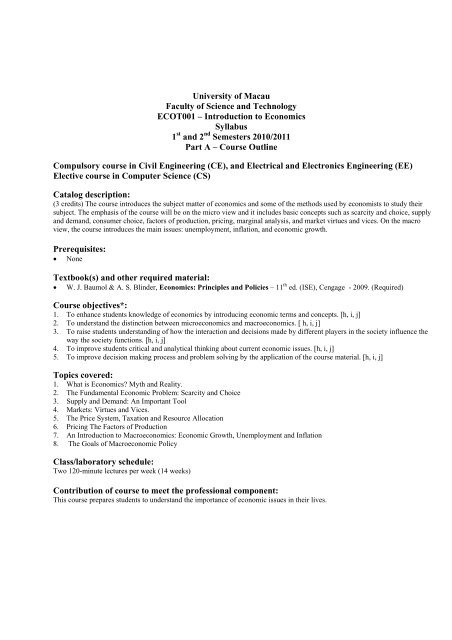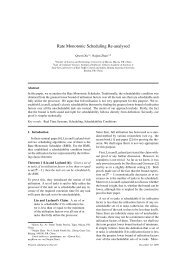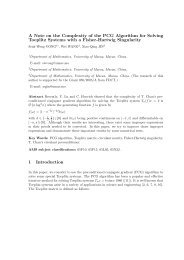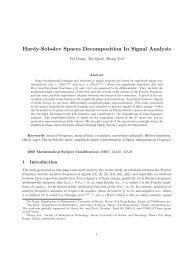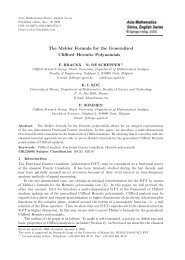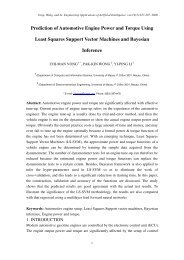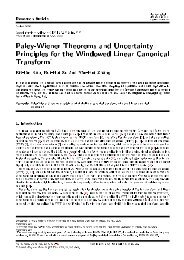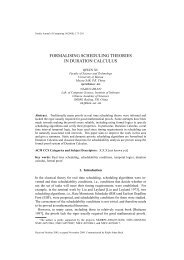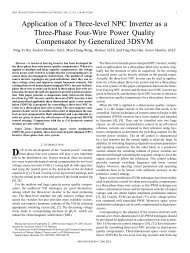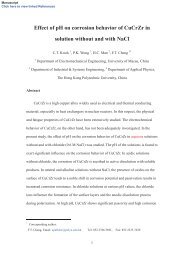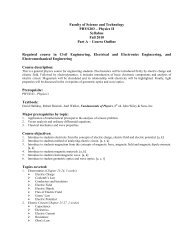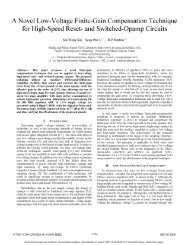Introduction to Economics Syllabus 1 and 2 Semesters 2010/2011
Introduction to Economics Syllabus 1 and 2 Semesters 2010/2011
Introduction to Economics Syllabus 1 and 2 Semesters 2010/2011
You also want an ePaper? Increase the reach of your titles
YUMPU automatically turns print PDFs into web optimized ePapers that Google loves.
University of Macau<br />
Faculty of Science <strong>and</strong> Technology<br />
ECOT001 – <strong>Introduction</strong> <strong>to</strong> <strong>Economics</strong><br />
<strong>Syllabus</strong><br />
1 st <strong>and</strong> 2 nd <strong>Semesters</strong> <strong>2010</strong>/<strong>2011</strong><br />
Part A – Course Outline<br />
Compulsory course in Civil Engineering (CE), <strong>and</strong> Electrical <strong>and</strong> Electronics Engineering (EE)<br />
Elective course in Computer Science (CS)<br />
Catalog description:<br />
(3 credits) The course introduces the subject matter of economics <strong>and</strong> some of the methods used by economists <strong>to</strong> study their<br />
subject. The emphasis of the course will be on the micro view <strong>and</strong> it includes basic concepts such as scarcity <strong>and</strong> choice, supply<br />
<strong>and</strong> dem<strong>and</strong>, consumer choice, fac<strong>to</strong>rs of production, pricing, marginal analysis, <strong>and</strong> market virtues <strong>and</strong> vices. On the macro<br />
view, the course introduces the main issues: unemployment, inflation, <strong>and</strong> economic growth.<br />
Prerequisites:<br />
None<br />
Textbook(s) <strong>and</strong> other required material:<br />
W. J. Baumol & A. S. Blinder, <strong>Economics</strong>: Principles <strong>and</strong> Policies – 11 th ed. (ISE), Cengage - 2009. (Required)<br />
Course objectives*:<br />
1. To enhance students knowledge of economics by introducing economic terms <strong>and</strong> concepts. [h, i, j]<br />
2. To underst<strong>and</strong> the distinction between microeconomics <strong>and</strong> macroeconomics. [ h, i, j]<br />
3. To raise students underst<strong>and</strong>ing of how the interaction <strong>and</strong> decisions made by different players in the society influence the<br />
way the society functions. [h, i, j]<br />
4. To improve students critical <strong>and</strong> analytical thinking about current economic issues. [h, i, j]<br />
5. To improve decision making process <strong>and</strong> problem solving by the application of the course material. [h, i, j]<br />
Topics covered:<br />
1. What is <strong>Economics</strong>? Myth <strong>and</strong> Reality.<br />
2. The Fundamental Economic Problem: Scarcity <strong>and</strong> Choice<br />
3. Supply <strong>and</strong> Dem<strong>and</strong>: An Important Tool<br />
4. Markets: Virtues <strong>and</strong> Vices.<br />
5. The Price System, Taxation <strong>and</strong> Resource Allocation<br />
6. Pricing The Fac<strong>to</strong>rs of Production<br />
7. An <strong>Introduction</strong> <strong>to</strong> Macroeconomics: Economic Growth, Unemployment <strong>and</strong> Inflation<br />
8. The Goals of Macroeconomic Policy<br />
Class/labora<strong>to</strong>ry schedule:<br />
Two 120-minute lectures per week (14 weeks)<br />
Contribution of course <strong>to</strong> meet the professional component:<br />
This course prepares students <strong>to</strong> underst<strong>and</strong> the importance of economic issues in their lives.
Relationship <strong>to</strong> CE, EE <strong>and</strong> CS programs objectives <strong>and</strong> outcomes:<br />
This course primarily contributes <strong>to</strong> CE, EE <strong>and</strong> CS programs outcomes that develop student abilities <strong>to</strong>:<br />
(h) The broad education necessary <strong>to</strong> underst<strong>and</strong> the impact of engineering solutions in a global, economic,<br />
environmental, <strong>and</strong> societal context<br />
(j) A knowledge of contemporary issues<br />
This course secondarily contributes <strong>to</strong> CE, EE <strong>and</strong> CS programs outcomes that develop student abilities <strong>to</strong>:<br />
(i) A recognition of the need for, <strong>and</strong> an ability <strong>to</strong> engage in lifelong learning.<br />
Coordina<strong>to</strong>r:<br />
Miguel Costa, Senior Instruc<strong>to</strong>r<br />
Persons who prepared this description:<br />
Miguel Costa, May 24, <strong>2010</strong><br />
_________________________________________________________________________
Part B General Course Information <strong>and</strong> Policies<br />
1nd <strong>and</strong> 2 nd <strong>Semesters</strong><br />
Instruc<strong>to</strong>r: Mr. Miguel Costa Office: N327B<br />
Office Hour: TBA or by appointment Phone: 83974378<br />
Email: mcosta@umac.mo<br />
Time/Venue:<br />
TBA<br />
Assessment:<br />
Final assessment will be determined on the basis of:<br />
In-class exercises 10 % e-Quizzes 20% Mid-term 20% Mid-term II 20%<br />
Final Exam 30%<br />
Grading Distribution:<br />
Grades are awarded according <strong>to</strong> the following system:<br />
Letter Grades A A- B+ B B- C+ C C- D+ D F<br />
Grade Points 4.0 3.7 3.3 3.0 2.7 2.3 2.0 1.7 1.3 1 0<br />
Percentage 93-100 88-92 83-87 78-82 73-77 68-72 63-67 58-62 53-57 50-52 Below 50<br />
Scale 19-20 18 17 16 15 14 13 12 11 10 Below 10<br />
The credit is earned by the achievement of a grade from ‘A’ <strong>to</strong> ‘D’; ‘F’ carries zero credit.<br />
Comment:<br />
The objectives of the lectures are <strong>to</strong> explain <strong>and</strong> <strong>to</strong> supplement the text material. Students are responsible for<br />
the assigned material whether or not it is covered in the lecture. Students who wish <strong>to</strong> succeed in this course<br />
should read the textbook (chapter related) prior <strong>to</strong> the lecture, should work all in-class exercises <strong>and</strong> e-<br />
quizzes (homework) <strong>and</strong> should made use of the material provided at UMMoodle such as examples <strong>and</strong> extra<br />
material. You are encouraged <strong>to</strong> look at other sources (such as other textbooks, websites, etc.) <strong>to</strong> complement<br />
the lectures <strong>and</strong> text.<br />
Homework Policy:<br />
The completion <strong>and</strong> correction of the in-class exercises <strong>and</strong> e-quizzes are a powerful learning experience.<br />
There will be approximately 6 in-class exercises.<br />
There will be approximately 8 e-quizzes. E-quizzes have a period for completion that must be respected.<br />
No late submission is accepted.<br />
Exams<br />
Two mid-term exams <strong>and</strong> one final exam will be held during the semester.<br />
Note<br />
The lecture session is an important part of this course <strong>and</strong> attendance is compulsory. At most 20%<br />
absence without leave is allowed.<br />
Check UMMoodle (ummoodle.umac.mo) regularly for announcements, e-quizzes <strong>and</strong> lectures. Report<br />
any mistake on your grades within one week after posting.<br />
No make-up exam will be given except for CLEAR justification such as medical proof.<br />
Cheating <strong>and</strong> plagiarism are absolutely prohibited by the university.


